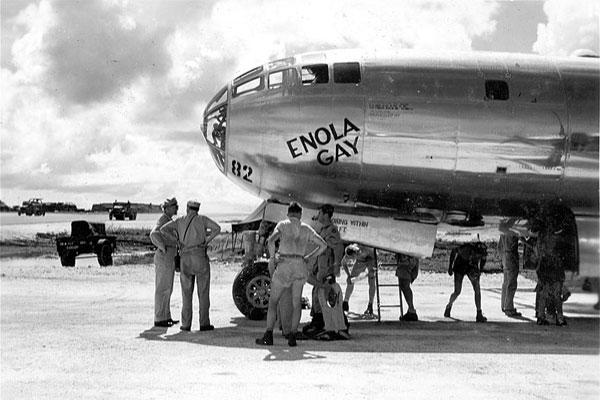Shortly after the atomic bomb was dropped on Hiroshima on Aug. 6, 1945, the Enola Gay's tail gunner Bob Caron wrote his wife that the crew had just received a medal and she'd be reading about what they had done in the newspapers.
"It seems our crew and airplanes made history or something," wrote then-Tech Sgt. George Robert "Bob" Caron, of Wendover, Utah. "When they let us write about it from here, I'll be able to tell you all about it. Our picture will probably be all over the states before we can say anything."
Caron and others in the 11-member crew of the B-29 Superfortress still weren't quite sure what it was that had dropped from the bomb bay on that bright morning 70 years ago, but Caron was the first to see the effects from his position in the tail. They had given him a K-20 camera to take the first photos.
The pilot, Col. Paul Tibbets, who named the B-29 the "Enola Gay" after his mother, told Caron to describe what he saw to the crew over the intercom.
"It was an awesome sight. I described the mushroom cloud as it grows. Well, it was white on the outside and it was sort of a purplish black towards the interior, and it had a fiery red core, and it just kept boiling up. I think that's how I described it on the intercom," Caron said years later in an interview.
"As we got further away, I could see the city then, not just the mushroom, coming up. I could see the city, and it was being covered with this low, bubbling mass. It looked like bubbling molasses, let's say, spreading out and running up into the foothills, just covering the whole city."
"And fires, I could see fires spring up through this undercast, or whatever you would call it, that was covering the city. Flames in different spots would be springing up. It was about that time that Tibbets turned the airplane around, so that everybody could get a look at it."
Then the co-pilot, Capt. Robert A. Lewis, of Brooklyn, N.Y., saw it. He was keeping a log of the flight, scribbling on the backs of old War Department forms. He wrote:
''If I live a hundred years, I'll never quite get these few minutes out of my mind. Everyone on the ship is actually dumbstruck even though we had expected something fierce."
"I honestly have the feeling of groping for words to explain this or I might say, my God, what have we done?"
Lewis, Caron and the others, however, would later say they had no regrets about dropping the bomb. It had hastened the end of the war and saved the lives of U.S. troops who were then preparing for the invasion of Japan.
Capt. Theodore "Dutch" Van Kirk, of Northumberland, Pa., later said that "I honestly believe the use of the atomic bomb saved lives in the long run, but I pray no man will have to witness that sight again. Such a terrible waste, such a loss of life."
The crew also hoped that the bomb would never be used again but it was, three days later on Aug. 9, when a B-29 called "Bockscar" dropped another atomic bomb on Nagasaki.
Army Air Forces 2nd Lt. Jacob Beser would be the only one to see the aftermath of both explosions. He was a radarman on the Enola Gay and performed the same duties on Bockscar.
Beser would later write that "No, I feel no sorrow or remorse for whatever small role I played. That I should is crazy. I remember Pearl Harbor and all of the Japanese atrocities."
"I remember the shock to our nation that all of this brought. I don't want to hear any discussion of morality. War, by its very nature, is immoral."
-- Richard Sisk can be reached at richard.sisk@military.com




























